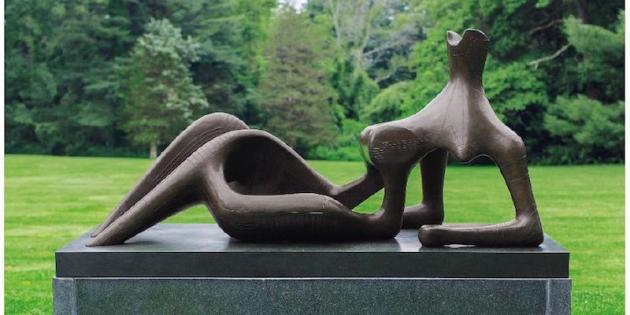A rare Henry Moore 1951 modernist bronze sculpture ‘Reclining Figure’ created for the Festival of Britain, will lead the sculpture section of Christie’s 250th anniversary auction, Defining British Art, in London on 30 June (estimate: £15-20 million). It will be offered alongside further large-scale major British sculptures by Dame Barbara Hepworth, Sea Form (Atlantic), 1964 (estimate: £3-5 million) and Lynn Chadwick, Back to Venice, 1988, which is offered from the artist’s estate (estimate: £1.4-1.8 million).
Deputy Chairman, Cyanne Chutkow, Impressionist & Modern Art, Christie’s: said, “Reclining Figure: Festival is one of the great masterpieces of Moore’s oeuvre and is arguably his most masterful and elegant sculptural synthesis of form and space. Privately held in an American collection for almost a half century, this work is a testament to the owners’ discerning and sophisticated artistic sensibility.”
Reclining Figure: Festival was commissioned by the Arts Council of Great Britain for the 1951 Festival of Britain, where, as a focal point on the newly-built South Bank, it symbolised for many visitors the resilience and inventiveness of the British people in the wake of the Second World War. Reclining Figure: Festival is the artist’s first, large reclining figure to have been cast in bronze and in many ways represents the pinnacle of Moore’s repeated exploration, since the late 1920s, of the reclining human form and his pioneering attempt to integrate this form with a sense of both landscape and space. Moore himself claimed that Reclining Figure: Festival is, the ‘first sculpture in which I succeeded in making form and space sculpturally inseparable’ and singled it out as one of the most important sculptures of his entire oeuvre.
The complex, almost balletic interpenetration of material and space that combines together in Reclining Figure: Festival to form a single, united and yet still distinctly human image is something that marked both a peak and a turning point in Moore’s work – a moment that represented the ultimate attainment of the artist’s twenty-year pioneering exploration of the sculptural potential of the reclining figure tradition
Moore seems to have known from the outset that it would prove to be a landmark work in the history of his art and, in 1951, in conjunction with the filmmaker John Read, ensured that every stage of the genesis and realisation of this work was documented on film for what became the first of a series of ground-breaking documentary films by Read on the artist at work.
Created three years after Moore was awarded the International prize for sculpture at the 1948 Venice Biennale, one of an edition of five bronze casts and one artist’s proof, Reclining Figure: Festival was made from Moore’s plaster original, now in the Tate Gallery, London. The first bronze cast of the work that Moore made is the version that was displayed at the Festival of Britain in 1951, later acquired by the Scottish National Gallery of Modern Art. The Musée National d’Art Moderne in Paris also owns one cast. Christie’s set a world record price for Moore when another cast from the edition was sold for £19,081,250 in London, February 2012.
Sea Form (Atlantic) is a large curved and free-standing bronze sculpture made by Moore’s wife Dame Barbara Hepworth in 1964 (estimate: £3-5 million). Standing at over two metres high, it is one of a great series of large-scale bronze sculptures Hepworth made in the late 1950s and 60s in which she sought to invoke a deep sense of the human figure and the landscape through a single, generalised form that she hoped would be displayed in the open air. Sea Form (Atlantic) was produced in an edition of six bronze casts plus one artist’s proof. Other casts are currently housed in the Museum of Fine Arts, Dallas, the City of Norwich Museums, the Lyndon Sculpture Garden and the artist’s estate, St Ives.
Sea Form (Atlantic) is one of an important group of bronze sculptures to which
Hepworth gave the name ‘Sea Form’ on account of their resemblance to forms and feelings prompted in her by the sights, sounds and sensations of the Cornish coastline with which she said she had become ‘bewitched’. The elegant human scale of the work, its simplified forms and sea-green coloured, oval hollows are all intended to evoke, in both a physical and material way, a sense of the experience Hepworth herself had while walking along the dramatic Atlantic coastline between St Ives and Land’s End, taking in its jutting rocks, calm hollows, languid pools, windswept beaches and the ever-present ‘infinitude’ of the sea. Hepworth’s Sea Form sculptures were all made in bronze because it was this metal, she believed, that allowed her the lightness, flexibility and freedom to create forms evocative of the ebb and flow of the waves, the bend and curve of the wind and the roughness of the rocky coastline.

